 Backend Development
Backend Development
 Python Tutorial
Python Tutorial
 Detailed analysis of Python's implementation of scheduled tasks apscheduler
Detailed analysis of Python's implementation of scheduled tasks apscheduler
Detailed analysis of Python's implementation of scheduled tasks apscheduler
This article brings you relevant knowledge about Python, which mainly introduces related issues about implementing scheduled tasks. You can use third-party packages to manage scheduled tasks. Relatively speaking, apscheduler uses It's simpler to use. Let's take a look at the method of use. I hope it will be helpful to everyone.
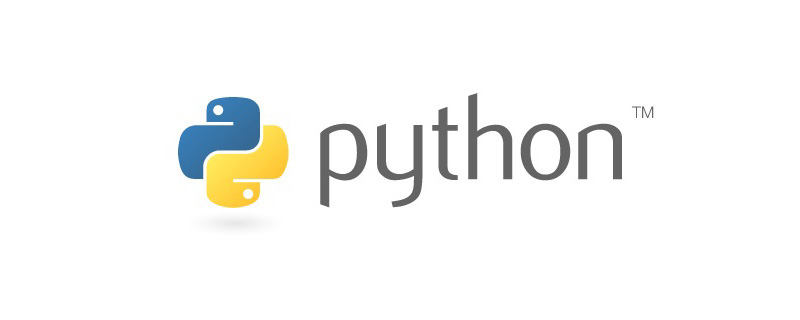
[Related recommendations: Python3 video tutorial]
First introduction to apscheduler
Let’s take a simple example See how apscheduler is used.
#encoding:utf-8
from apscheduler.schedulers.blocking import BlockingScheduler
import datetime
def sch_test():
now = datetime.datetime.now().strftime('%Y-%m-%d %H:%M:%S')
print('时间:{}, 测试apscheduler'.format(now))
task = BlockingScheduler()
task.add_job(func=sch_test, trigger='cron', second='*/10')
task.start()The above example is very simple. We first need to define an apscheduler object, then add_job to add the task, and finally start the task.
The example is to run the sch_test task every 10 seconds. The running results are as follows:
时间:2022-10-08 15:16:30, 测试apscheduler 时间:2022-10-08 15:16:40, 测试apscheduler 时间:2022-10-08 15:16:50, 测试apscheduler 时间:2022-10-08 15:17:00, 测试apscheduler
If we want to carry parameters when executing the task function, just add args to the add_job function, such as task .add_job(func=sch_test, args=('a'), trigger='cron', second='*/10').
What modules does apscheduler have?
In the above example, we have a preliminary understanding of how to use apschedulerl. Next, we need to know the design framework of apscheduler. apscheduler has four main modules: triggers, job_stores, executors, and schedulers.
1. Triggers:
Trigger refers to the triggering method specified by the task. In the example we use "cron" Way. We can choose one of cron, date, and interval.
Cron represents a scheduled task, similar to linux crontab, which is triggered at a specified time.
The available parameters are as follows:

In addition, we can also use expression types to set cron. For example, commonly used ones are:
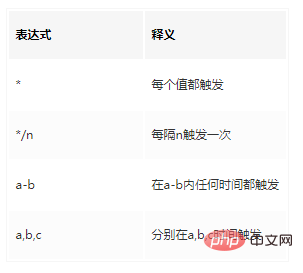
Usage example, executed once every day at 7:20:
task.add_job(func=sch_test, args=( 'Timed task',), trigger='cron',
hour='7', minute='20')
date represents a one-time task specific to a certain time;
Usage example:
# 使用run_date指定运行时间 task.add_job(func='sch_test', trigger='date', run_date=datetime.datetime(2022 ,10 , 8, 16, 1, 30)) # 或者用next_run_time task.add_job(func=sch_test,trigger='date', next_run_time=datetime.datetime.now() + datetime.timedelta(seconds=3))
interval represents a cyclic task, specifies an interval, and executes it every time the interval passes.
interval can set the following parameters:
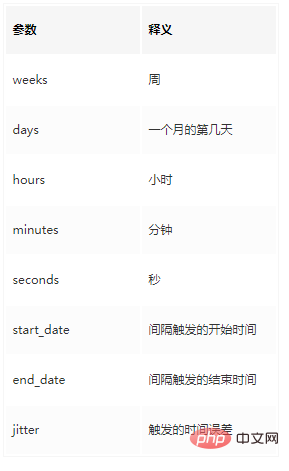
# Usage example, execute the sch_test task every 3 seconds:
task.add_job(func=sch_test, args=('循环任务',), trigger='interval', seconds=3)。
Come on The example uses all three triggers:
# encoding:utf-8
from apscheduler.schedulers.blocking import BlockingScheduler
import datetime
def sch_test(job_type):
now = datetime.datetime.now().strftime('%Y-%m-%d %H:%M:%S')
print('时间:{}, {}测试apscheduler'.format(now, job_type))
task = BlockingScheduler()
task.add_job(func=sch_test, args=('一次性任务',),trigger='date', next_run_time=datetime.datetime.now() + datetime.timedelta(seconds=3))
task.add_job(func=sch_test, args=('定时任务',), trigger='cron', second='*/5')
task.add_job(func=sch_test, args=('循环任务',), trigger='interval', seconds=3)
task.start()Print part of the results:
时间:2022-10-08 15:45:49, 一次性任务测试apscheduler 时间:2022-10-08 15:45:49, 循环任务测试apscheduler 时间:2022-10-08 15:45:50, 定时任务测试apscheduler 时间:2022-10-08 15:45:52, 循环任务测试apscheduler 时间:2022-10-08 15:45:55, 定时任务测试apscheduler 时间:2022-10-08 15:45:55, 循环任务测试apscheduler 时间:2022-10-08 15:45:58, 循环任务测试apscheduler
Through code examples and result display, we can clearly know the difference in the use of different triggers.
2. Task storage job_stores
As the name suggests, task storage is where tasks are stored, and they are stored in memory by default. We can also customize the storage method, such as saving tasks in mysql. There are several options here:
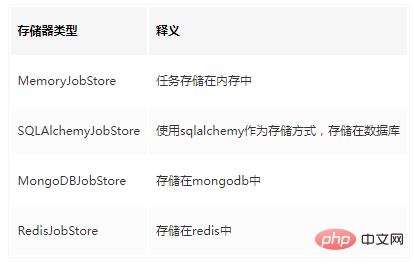
Usually the default is to store it in the memory, but if the program fails and restarts, the task will be pulled and run again. If the execution requirements are high, you can choose other memories.
Example of using SQLAlchemyJobStore storage:
from apscheduler.schedulers.blocking import BlockingScheduler
def sch_test(job_type):
now = datetime.datetime.now().strftime('%Y-%m-%d %H:%M:%S')
print('时间:{}, {}测试apscheduler'.format(now, job_type))
sched = BlockingScheduler()
# 使用mysql存储任务
sql_url = 'mysql+pymysql://root:root@localhost:3306/db_name?charset=utf8'
sched.add_jobstore('sqlalchemy',url=sql_url)
# 添加任务
sched.add_job(func=sch_test, args=('定时任务',), trigger='cron', second='*/5')
sched.start()3. Executor executors
The function of the executor is to put the task into Run in thread pool or process pool. There are several options:
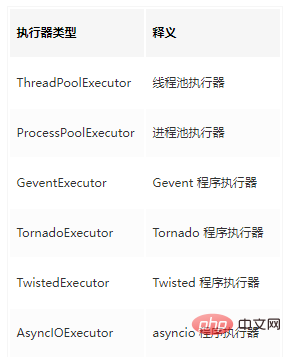
#The default is ThreadPoolExecutor, and the commonly used ones are thread and process pool executors. If the application is a CPU-intensive operation, ProcessPoolExecutor can be used to execute it.
4. Schedulers schedulers
The scheduler belongs to the core of apscheduler. It plays the role of coordinating the entire apscheduler system, including memory and executor. , the trigger runs normally under its schedule. There are several schedulers:
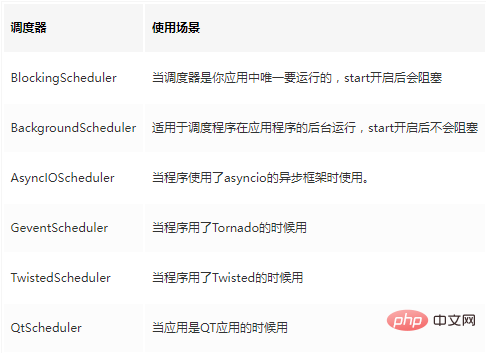
#Not in specific scenarios, the most commonly used scheduler is BlockingScheduler.
Exception monitoring
When the scheduled task is running, if an error occurs, a monitoring mechanism needs to be set up. We usually use the logging module to record error information.
Usage example:
from apscheduler.schedulers.blocking import BlockingScheduler
import datetime
from apscheduler.events import EVENT_JOB_EXECUTED , EVENT_JOB_ERROR
import logging
# logging日志配置打印格式及保存位置
logging.basicConfig(level=logging.INFO,
format='%(asctime)s %(filename)s[line:%(lineno)d] %(levelname)s %(message)s',
datefmt='%Y-%m-%d %H:%M:%S',
filename='sche.log',
filemode='a')
def log_listen(event):
if event.exception :
print ( '任务出错,报错信息:{}'.format(event.exception))
else:
print ( '任务正常运行...' )
def sch_test(job_type):
now = datetime.datetime.now().strftime('%Y-%m-%d %H:%M:%S')
print('时间:{}, {}测试apscheduler'.format(now, job_type))
print(1/0)
sched = BlockingScheduler()
# 使用mysql存储任务
sql_url = 'mysql+pymysql://root:root@localhost:3306/db?charset=utf8'
sched.add_jobstore('sqlalchemy',url=sql_url)
# 添加任务
sched.add_job(func=sch_test, args=('定时任务',), trigger='cron', second='*/5')
# 配置任务执行完成及错误时的监听
sched.add_listener(log_listen, EVENT_JOB_EXECUTED | EVENT_JOB_ERROR)
# 配置日志监听
sched._logger = logging
sched.start()apscheduler encapsulation usage
上面介绍了apscheduler框架的主要模块,我们基本能掌握怎样使用apscheduler了。下面就来封装一下apscheduler吧,以后要用直接在这份代码上修改就行了。
from apscheduler.schedulers.blocking import BlockingScheduler
from apscheduler.executors.pool import ThreadPoolExecutor, ProcessPoolExecutor
from apscheduler.events import EVENT_JOB_EXECUTED , EVENT_JOB_ERROR
import logging
import logging.handlers
import os
import datetime
class LoggerUtils():
def init_logger(self, logger_name):
# 日志格式
formatter = logging.Formatter('%(asctime)s %(filename)s[line:%(lineno)d] %(levelname)s %(message)s')
log_obj = logging.getLogger(logger_name)
log_obj.setLevel(logging.INFO)
# 设置log存储位置
path = '/data/logs/'
filename = '{}{}.log'.format(path, logger_name)
if not os.path.exists(path):
os.makedirs(path)
# 设置日志按照时间分割
timeHandler = logging.handlers.TimedRotatingFileHandler(
filename,
when='D', # 按照什么维度切割, S:秒,M:分,H:小时,D:天,W:周
interval=1, # 多少天切割一次
backupCount=10 # 保留几天
)
timeHandler.setLevel(logging.INFO)
timeHandler.setFormatter(formatter)
log_obj.addHandler(timeHandler)
return log_obj
class Scheduler(LoggerUtils):
def __init__(self):
# 执行器设置
executors = {
'default': ThreadPoolExecutor(10), # 设置一个名为“default”的ThreadPoolExecutor,其worker值为10
'processpool': ProcessPoolExecutor(5) # 设置一个名为“processpool”的ProcessPoolExecutor,其worker值为5
}
self.scheduler = BlockingScheduler(timezone="Asia/Shanghai", executors=executors)
# 存储器设置
# 这里使用sqlalchemy存储器,将任务存储在mysql
sql_url = 'mysql+pymysql://root:root@localhost:3306/db?charset=utf8'
self.scheduler.add_jobstore('sqlalchemy',url=sql_url)
def log_listen(event):
if event.exception:
# 日志记录
self.scheduler._logger.error(event.traceback)
# 配置任务执行完成及错误时的监听
self.scheduler.add_listener(log_listen, EVENT_JOB_EXECUTED | EVENT_JOB_ERROR)
# 配置日志监听
self.scheduler._logger = self.init_logger('sche_test')
def add_job(self, *args, **kwargs):
"""添加任务"""
self.scheduler.add_job(*args, **kwargs)
def start(self):
"""开启任务"""
self.scheduler.start()
# 测试任务
def sch_test(job_type):
now = datetime.datetime.now().strftime('%Y-%m-%d %H:%M:%S')
print('时间:{}, {}测试apscheduler'.format(now, job_type))
print(1/0)
# 添加任务,开启任务
sched = Scheduler()
# 添加任务
sched.add_job(func=sch_test, args=('定时任务',), trigger='cron', second='*/5')
# 开启任务
sched.start()【相关推荐:Python3视频教程 】
The above is the detailed content of Detailed analysis of Python's implementation of scheduled tasks apscheduler. For more information, please follow other related articles on the PHP Chinese website!

Hot AI Tools

Undresser.AI Undress
AI-powered app for creating realistic nude photos

AI Clothes Remover
Online AI tool for removing clothes from photos.

Undress AI Tool
Undress images for free

Clothoff.io
AI clothes remover

Video Face Swap
Swap faces in any video effortlessly with our completely free AI face swap tool!

Hot Article

Hot Tools

Notepad++7.3.1
Easy-to-use and free code editor

SublimeText3 Chinese version
Chinese version, very easy to use

Zend Studio 13.0.1
Powerful PHP integrated development environment

Dreamweaver CS6
Visual web development tools

SublimeText3 Mac version
God-level code editing software (SublimeText3)

Hot Topics
 1386
1386
 52
52
 Can vs code run in Windows 8
Apr 15, 2025 pm 07:24 PM
Can vs code run in Windows 8
Apr 15, 2025 pm 07:24 PM
VS Code can run on Windows 8, but the experience may not be great. First make sure the system has been updated to the latest patch, then download the VS Code installation package that matches the system architecture and install it as prompted. After installation, be aware that some extensions may be incompatible with Windows 8 and need to look for alternative extensions or use newer Windows systems in a virtual machine. Install the necessary extensions to check whether they work properly. Although VS Code is feasible on Windows 8, it is recommended to upgrade to a newer Windows system for a better development experience and security.
 How to run programs in terminal vscode
Apr 15, 2025 pm 06:42 PM
How to run programs in terminal vscode
Apr 15, 2025 pm 06:42 PM
In VS Code, you can run the program in the terminal through the following steps: Prepare the code and open the integrated terminal to ensure that the code directory is consistent with the terminal working directory. Select the run command according to the programming language (such as Python's python your_file_name.py) to check whether it runs successfully and resolve errors. Use the debugger to improve debugging efficiency.
 Can visual studio code be used in python
Apr 15, 2025 pm 08:18 PM
Can visual studio code be used in python
Apr 15, 2025 pm 08:18 PM
VS Code can be used to write Python and provides many features that make it an ideal tool for developing Python applications. It allows users to: install Python extensions to get functions such as code completion, syntax highlighting, and debugging. Use the debugger to track code step by step, find and fix errors. Integrate Git for version control. Use code formatting tools to maintain code consistency. Use the Linting tool to spot potential problems ahead of time.
 Is the vscode extension malicious?
Apr 15, 2025 pm 07:57 PM
Is the vscode extension malicious?
Apr 15, 2025 pm 07:57 PM
VS Code extensions pose malicious risks, such as hiding malicious code, exploiting vulnerabilities, and masturbating as legitimate extensions. Methods to identify malicious extensions include: checking publishers, reading comments, checking code, and installing with caution. Security measures also include: security awareness, good habits, regular updates and antivirus software.
 Python: Automation, Scripting, and Task Management
Apr 16, 2025 am 12:14 AM
Python: Automation, Scripting, and Task Management
Apr 16, 2025 am 12:14 AM
Python excels in automation, scripting, and task management. 1) Automation: File backup is realized through standard libraries such as os and shutil. 2) Script writing: Use the psutil library to monitor system resources. 3) Task management: Use the schedule library to schedule tasks. Python's ease of use and rich library support makes it the preferred tool in these areas.
 What is vscode What is vscode for?
Apr 15, 2025 pm 06:45 PM
What is vscode What is vscode for?
Apr 15, 2025 pm 06:45 PM
VS Code is the full name Visual Studio Code, which is a free and open source cross-platform code editor and development environment developed by Microsoft. It supports a wide range of programming languages and provides syntax highlighting, code automatic completion, code snippets and smart prompts to improve development efficiency. Through a rich extension ecosystem, users can add extensions to specific needs and languages, such as debuggers, code formatting tools, and Git integrations. VS Code also includes an intuitive debugger that helps quickly find and resolve bugs in your code.
 Python vs. JavaScript: The Learning Curve and Ease of Use
Apr 16, 2025 am 12:12 AM
Python vs. JavaScript: The Learning Curve and Ease of Use
Apr 16, 2025 am 12:12 AM
Python is more suitable for beginners, with a smooth learning curve and concise syntax; JavaScript is suitable for front-end development, with a steep learning curve and flexible syntax. 1. Python syntax is intuitive and suitable for data science and back-end development. 2. JavaScript is flexible and widely used in front-end and server-side programming.
 Golang vs. Python: Concurrency and Multithreading
Apr 17, 2025 am 12:20 AM
Golang vs. Python: Concurrency and Multithreading
Apr 17, 2025 am 12:20 AM
Golang is more suitable for high concurrency tasks, while Python has more advantages in flexibility. 1.Golang efficiently handles concurrency through goroutine and channel. 2. Python relies on threading and asyncio, which is affected by GIL, but provides multiple concurrency methods. The choice should be based on specific needs.



